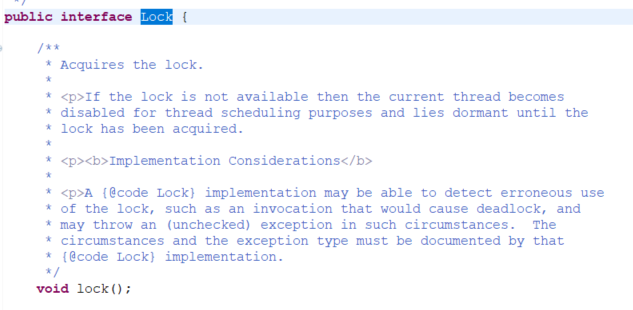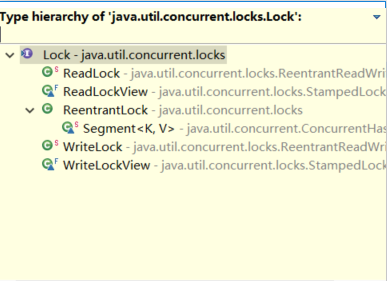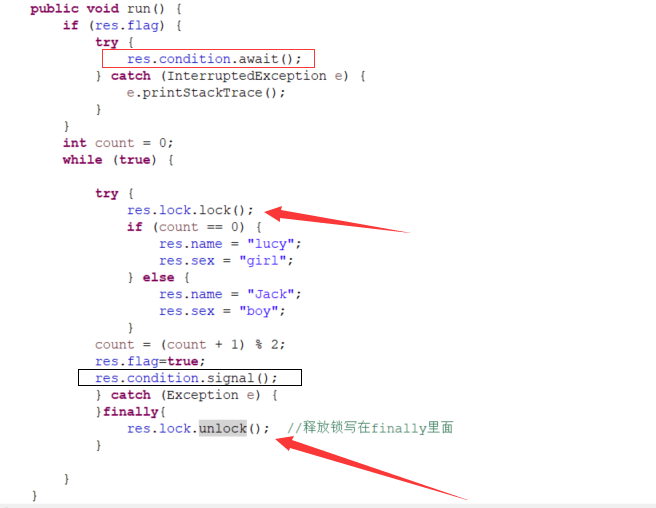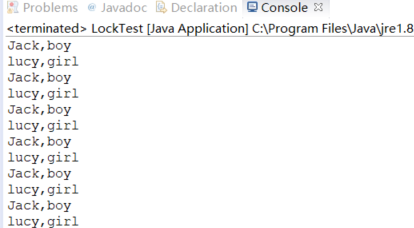关于lock锁
在 jdk1.5 之后,并发包中新增了 Lock 接口(以及相关实现类)用来实现锁功能,Lock 接口提供了与 synchronized 关键字类似的同步功能,但需要在使用时手动获取锁和释放锁。
lock锁 也叫显示锁
大家看下这个lock锁:

lock是个接口
这个接口下面很多锁:

对于lock锁的使用,实现生产者消费者模式的:
package com.toov5.thread;
import java.util.concurrent.locks.Lock;
import java.util.concurrent.locks.ReentrantLock;
//共享对象
class ResLock {
public boolean flag = true;
public String sex;
public String name;
public Lock lock = new ReentrantLock();
}
class inputThreadLock extends Thread {
public ResLock res;
public inputThreadLock(ResLock res) {
this.res = res;
}
@Override
public void run() {
int count = 0;
while (true) {
try {
res.lock.lock();
if (count == 0) {
res.name = "lucy";
res.sex = "girl";
} else {
res.name = "Jack";
res.sex = "boy";
}
count = (count + 1) % 2;
} catch (Exception e) {
}finally{
res.lock.unlock(); //释放锁写在finally里面
}
}
}
}
class readThreadLock extends Thread {
public ResLock res;
public readThreadLock(ResLock res) {
this.res = res;
}
@Override
public void run() {
while (true) {
try {
res.lock.lock();
System.out.println(res.name + "," + res.sex);
} catch (Exception e) {
e.printStackTrace();
}finally {
res.lock.unlock();
}
}
}
}
public class LockTest {
public static void main(String[] args) {
Res res = new Res();
inputThread inputThread = new inputThread(res);
readThread readThread = new readThread(res);
inputThread.start();
readThread.start();
}
}注意 unlock写到finally里面哦
然后lock锁里面的 类似于 notify 和 wait的 Condition
Condition的功能类似于在传统的线程技术中的,Object.wait()和Object.notify()的功能。
使用方法:
package com.toov5.thread;
import java.util.concurrent.locks.Condition;
import java.util.concurrent.locks.Lock;
import java.util.concurrent.locks.ReentrantLock;
//共享对象
class ResLock {
public boolean flag = true;
public String sex;
public String name;
public Lock lock = new ReentrantLock();
public Condition condition = lock.newCondition();
}
class inputThreadLock extends Thread {
public ResLock res;
public inputThreadLock(ResLock res) {
this.res = res;
}
@Override
public void run() {
if (res.flag) {
try {
res.condition.await();
} catch (InterruptedException e) {
e.printStackTrace();
}
}
int count = 0;
while (true) {
try {
res.lock.lock();
if (count == 0) {
res.name = "lucy";
res.sex = "girl";
} else {
res.name = "Jack";
res.sex = "boy";
}
count = (count + 1) % 2;
res.flag=true;
res.condition.signal();
} catch (Exception e) {
}finally{
res.lock.unlock(); //释放锁写在finally里面
}
}
}
}
class readThreadLock extends Thread {
public ResLock res;
public readThreadLock(ResLock res) {
this.res = res;
}
@Override
public void run() {
while (true) {
try {
res.lock.lock();
if (res.flag) {
res.condition.await();
}
System.out.println(res.name + "," + res.sex);
res.condition.signal();
} catch (Exception e) {
e.printStackTrace();
}finally {
res.lock.unlock();
}
}
}
}
public class LockTest {
public static void main(String[] args) {
Res res = new Res();
inputThread inputThread = new inputThread(res);
readThread readThread = new readThread(res);
inputThread.start();
readThread.start();
}
}
执行结果:

Lock与synchronized 关键字的区别
Lock 接口可以尝试非阻塞地获取锁 当前线程尝试获取锁。如果这一时刻锁没有被其他线程获取到,则成功获取并持有锁。
Lock 接口能被中断地获取锁 与 synchronized 不同,获取到锁的线程能够响应中断,当获取到的锁的线程被中断时,中断异常将会被抛出,同时锁会被释放。
Lock 接口在指定的截止时间之前获取锁,如果截止时间到了依旧无法获取锁,则返回。
synchronize重量级锁 不可控制 释放锁 遇到异常 或者代码执行完毕后 释放锁
lock轻量级 可控释放锁 更灵活一些 lock是1.5出来的 比synchronize晚 弥补了一些不足 还有读写锁 重入锁 功能要强大一些





 本文深入探讨了Java并发包中的Lock接口及其相关实现类,对比synchronized关键字,讲解了Lock锁的非阻塞性、中断响应性和定时锁获取特性。通过实例代码展示了Lock和Condition在生产者消费者模式中的应用。
本文深入探讨了Java并发包中的Lock接口及其相关实现类,对比synchronized关键字,讲解了Lock锁的非阻塞性、中断响应性和定时锁获取特性。通过实例代码展示了Lock和Condition在生产者消费者模式中的应用。
















 786
786

 被折叠的 条评论
为什么被折叠?
被折叠的 条评论
为什么被折叠?








